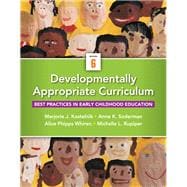Note: This is the loose-leaf version of Developmentally Appropriate Curriculum and does not include access to the Enhanced Pearson eText. To order the Enhanced Pearson eText packaged with the loose-leaf version, use ISBN 0133798062.
Helps students create the best programs for young children ages three through eight.
The authors’ goal in writing Developmentally Appropriate Curriculum: Best Practices in Early Childhood Education was to bring together the best information currently available for developing an integrated approach to curriculum and instruction in the early years.
The Sixth Edition addresses all aspects of classroom life, including the roles of children and adults, the physical and social environments, and teaching and learning within multiple domains for children age three to eight. It provides a comprehensive, cohesive approach to curriculum development, which results in greater continuity for children and practitioners in group settings in childcare, preschool, and the early elementary grades.
Concentrating as much on the “how” of curriculum development as on the “what and why,” the authors provide practical, research-based guidelines for translating theory into best practice that accommodates age-appropriateness, individual differences, and social and cultural diversity. Students learn how to conceptualize, plan, implement, and evaluate curriculum through detailed application opportunities in each chapter.
Improve mastery and retention with the Enhanced Pearson eText
The Enhanced Pearson eText provides a rich, interactive learning environment designed to improve student mastery of content. The Enhanced Pearson eText is:
- Engaging. The new interactive, multimedia learning features were developed by the authors and other subject-matter experts to deepen and enrich the learning experience.
- Convenient. Enjoy instant online access from your computer or download the Pearson eText App to read on or offline on your iPad® and Android® tablet.*
- Affordable. Experience the advantages of the Enhanced Pearson eText along with all the benefits of print for 40% to 50% less than a print bound book.
*The Pearson eText App is available on Google Play and in the App Store. It requires Android OS 3.1-4, a 7” or 10” tablet, or iPad iOS 5.0 or later.








